As an astrophotographer living under urban skies, finding the best light pollution filter for astrophotography often depends on individual preferences and the specific objects one aims to capture. For those interested in capturing true color images of deep sky objects while effectively blocking common sources of light pollution, the Optolong L-pro filter is a popular choice. Filters with ultra-high contrast, like the BAADER UHC filters, primarily transmit light in the blue and red regions of the spectrum, making them suitable for capturing emission and reflection nebulae. In astrophotography, narrowband filters are specialized tools that only allow a narrow range of specific wavelengths to pass through. They are utilized to isolate and capture light emitted by specific elements or gases in celestial objects, such as nebulae, even in the presence of light pollution or moonlight. If you’re using a color camera, the Optolong L-eNhance and L-eXtreme filters are both excellent and affordable options. For those venturing into narrowband imaging with a monochrome camera, the ZWO 7nm H-alpha, S-ii, and Oiii filters come highly recommended. Additionally, the Optolong H-alpha, S-ii, and Oiii filters, available in 6.5nm or 3nm variants, offer affordability and quality on today’s astrophotography market.
I have organized this blog into three sections to assist you in selecting the most suitable light pollution filter. Initially, I will provide an explanation of what light pollution entails. The second part outlines five steps that can assist you in determining your filter preferences before embarking on the search for a suitable light pollution filter online. In the third part of the blog, I will delve into the details of popular light pollution filters that you may wish to consider, accompanied by links to reputable astrophotography stores. Please note that this blog represents my perspective on the topic. Feel free to contribute to the discussion by leaving a comment below the blog.
Part 1: What is light pollution?
In the vast expanse of the universe, objects emit light across various wavelengths. As astrophotographers, our primary focus is on capturing the visible portion of the light spectrum, which allows us to create captivating color images of celestial objects. These colors are typically found within the range of 400 to 700 nanometers (nm). Specifically, violet and blue light reside in the 400-500nm range, green and yellow light in the 500-600nm range, and orange and red light in the 600-700nm range. Ideally, we would prefer to photograph these deep sky objects under dark skies, where we can capture all the colors within the visible light spectrum, undisturbed by any light pollution.

Four main sources of city light pollution
Regrettably, light pollution poses a challenge in (sub)urban areas. Let’s explore the four main sources of light pollution: mercury lights, low-pressure sodium lights, high-pressure sodium lights, and LED lights. Mercury lights are commonly found in traffic lights and neon signs, emitting light at wavelengths around 400nm, close to 550nm, and at 575nm depending on the color. Low-pressure sodium lights, found in some older street lights, emit light at a specific wavelength of 585nm. High-pressure sodium lights, often seen in newer street lights and industrial areas, produce an orange glow with light ranging from 550nm to 650nm. LED lights, increasingly used in residential and industrial areas due to their efficiency, emit light across the entire visible spectrum, contributing to the prevalent white glow in many city skies.
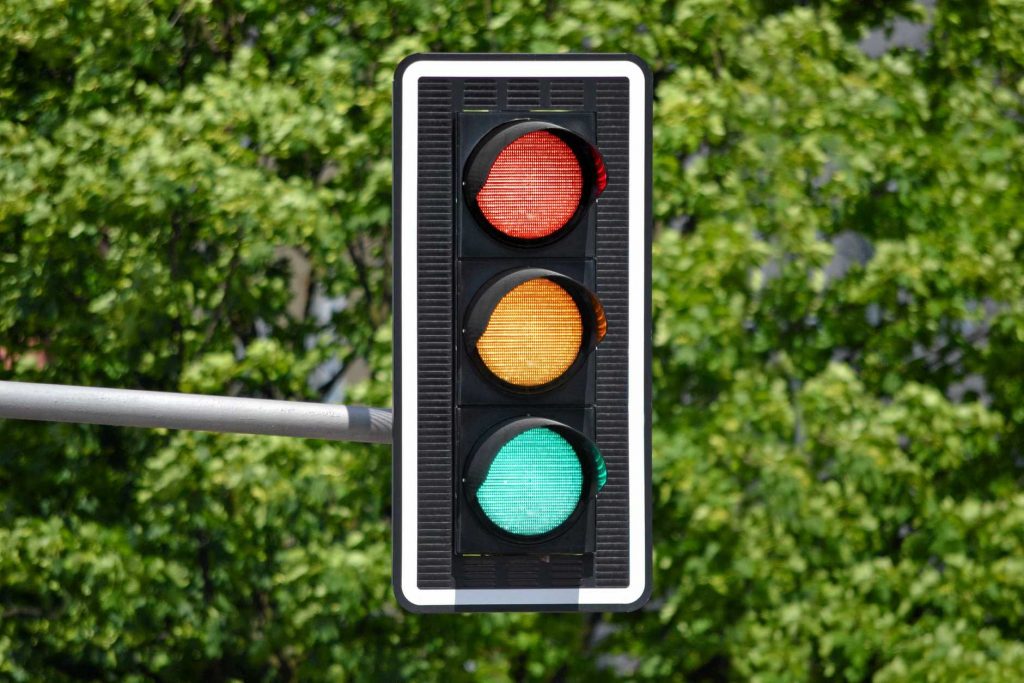


Thankfully, we have light pollution filters available to mitigate the impact of these artificial light sources. However, determining the “best” light pollution filter is subjective, much like choosing a car or telescope. It depends on your unique circumstances, the camera you’re planning to use, and your preferences for deep-sky objects. Hence, I’ll outline five steps to help you decide on the most suitable light pollution filters for your needs. Additionally, I’ll discuss popular light pollution filters currently available in the astromarket.
Part 2: Five steps to consider before buying a light pollution filter
Step 1: Check the severity of light pollution in your area
The first useful thing to do is to find out the severity of the light pollution you are dealing with. A good place to start is https://www.lightpollutionmap.info/ where you can check out the Bortle Class of the sky in your area. A good smartphone app is the Clear outside APP. This app gives you an accurate figure of the Bortle Class sky you are dealing with and it shows a detailed weather forecast as well.
Bortle Class
The Bortle class sky is a system devised by John E. Bortle to categorize the darkness and visibility of celestial objects in a given location. It classifies the quality of the night sky based on several criteria, including light pollution, sky glow, and overall visibility of stars, galaxies, and nebulae. The Bortle scale ranges from Class 1 (excellent dark sky) to Class 9 (severely light-polluted sky). Here’s a quick overview:
- 9 – Inner city skies; you are probably limited to seeing a couple of hundred stars during clear nights.
- 7 – Urban skies; about a thousand stars are visible on a clear night.
- 5 – Sub-urban skies; a couple of thousand stars are visible.
- 3 – Rural skies; About 5K stars are visible.
- 1 – Excellent dark sky site; close to 9K stars visible in the night sky on a clear night.
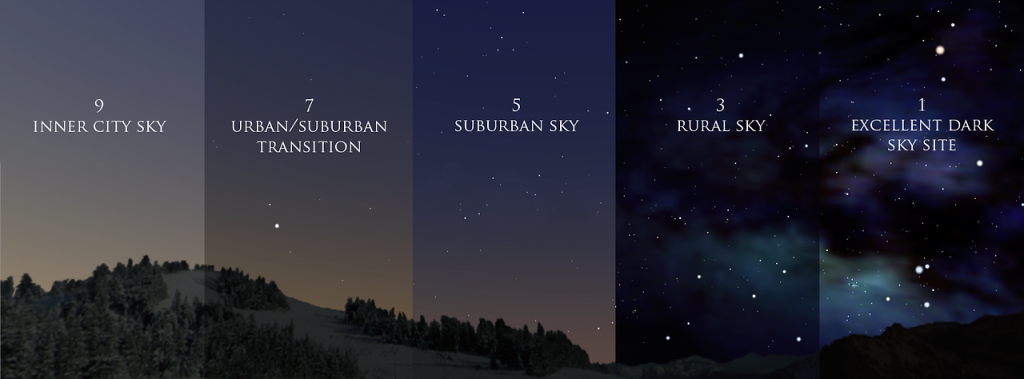
Of course, Bortle class is just one of the aspects you want to take into account when looking for excellent skies to perform astrophotography. If you’re interested in the different criteria you want to consider when selecting an excellent site for astrophotography, this is an excellent document to start. Undoubtedly, the optimal solution is to journey to a remote dark sky site for astrophotography, eliminating the need for light pollution filters. However, the reality is that our busy lifestyles often prevent us from venturing far from home, spending hours traveling and staying overnight at such locations. Additionally, there is a unique sense of excitement that arises when engaging in astrophotography from the comfort of one’s own balcony or backyard. Being intimately familiar with the night sky from our specific location and capturing deep-sky objects while being at home offers a special connection and satisfaction. Despite the challenges of light pollution, the convenience and personal connection to our surroundings make astrophotography from our homes a cherished experience.
Step 2: Check out what sources of light pollution you are dealing with
Have your neighbors recently installed those new LED lights? Alternatively, do you reside near an industrial area where high-pressure sodium lights create that distinctive orange nighttime glow? Depending on the particular light sources you encounter, it would be wise to select a light pollution filter that effectively blocks out the specific wavelengths emitted by the artificial sources in your vicinity. I will delve into this topic in more depth when examining each light pollution filter individually, providing detailed insights on how they address the specific challenges posed by different light sources.

Step 3: How much of the natural colors in space do you want to sacrifice to combat light pollution?
As the third step, let’s consider how much of the natural appearance of the sky you are willing to compromise in order to combat light pollution. There are various options available to you. If your goal is to minimize (or eliminate) artificial light pollution, you can explore Ultra High Contrast filters or delve into narrowband astrophotography (covered in the next step). These filters effectively block out a significant portion of the artificial light pollution you encounter. However, this comes with a trade-off. Many popular celestial targets, such as well-known galaxies (e.g., the Pinwheel Galaxy, the Whirlpool Galaxy, Andromeda Galaxy, and our own Milky Way) and star clusters (e.g., the Great Hercules Cluster, Omega Centauri Cluster), emit light in the yellow and orange range of the light spectrum. By employing a strong light pollution filter like an Ultra High Contrast filter (discussed in part 3 of this blog), you would also block a significant portion of the yellow and orange light, which coincides with the wavelengths where most urban light pollution occurs. Consequently, you may lose the opportunity to capture the captivating yellow/orange hues often present in the cores of galaxies and star clusters. Instead, the resulting image may exhibit a bluish tone representing the filtered light. However, there are light pollution filters available that allow you to capture a portion of the yellow and orange light, providing a balance between obtaining a (near) true-color representation of your astronomical subject while still mitigating a significant amount of light pollution in your area.
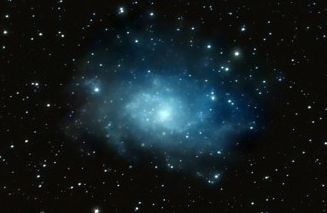
Step 4: Broadband versus Narrowband Astrophotography
Another consideration to ponder is whether you are open to abandoning your aspirations of capturing a true-color image and instead delve into narrowband astrophotography. Allow me to provide further insight into this concept. Broadband light pollution filters, such as the City Light Suppression (CLS) or Ultra High Contrast (UHC) filters, block out specific regions of the light spectrum that are heavily affected by light pollution, while still enabling the capture of some, if not most, of the genuine colors present in deep sky objects. However, the primary objective of narrowband astrophotography differs from this approach. Narrowband astrophotography aims to capture specific elements within deep sky objects. For instance, many nebulae in space consist of vast ionized hydrogen clouds, along with ionized sulfur and oxygen. Notably, these elements emit light at distinct wavelengths:
- Ionized hydrogen: H-alpha line at 656nm (H-Alpha filter)
- Ionized sulfur: Sii line at 672nm (SII filter)
- Oxygen: 500nm (OIII filter)
Narrowband filters, utilized by numerous astrophotographers, including myself, allow the creation of “false-color” images of deep sky objects. To provide an example, consider my image of the Horsehead Nebula, where I solely used a dedicated H-alpha filter to capture the ionized hydrogen emission of this target.
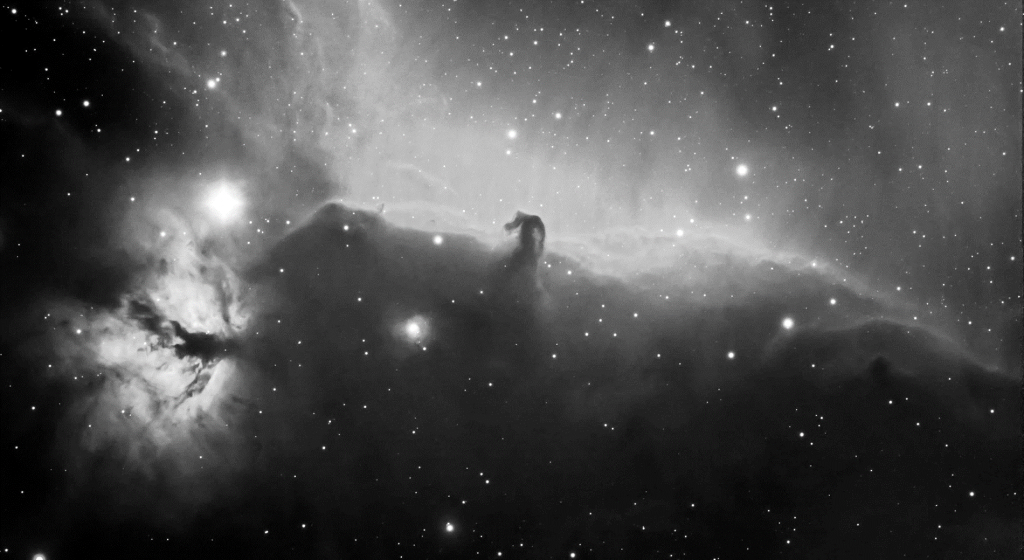
Another popular technique involves combining images captured with an H-alpha narrowband filter with a “true-color” image of a deep sky object. Returning to the Horsehead Nebula image, I merged the genuine colors of the nebula with the H-alpha image, resulting in a composite known as HaRGB (H-alpha + RGB).

In Part 3 of this discussion, I will delve into narrowband astrophotography in greater detail, exploring the various filters available for engaging in this captivating form of astrophotography.
Step 5: Be sure to buy the right filter size, depending on your astrophotography setup
Another crucial aspect to consider is determining the appropriate size of light pollution filters for your astrophotography setup. This will depend on your specific equipment configuration. Many seasoned astrophotographers utilize dedicated filter wheels positioned in front of their cameras, which typically accommodate either 1.25″ or 2″ filters. Opting for larger 2″ filters offers the advantage of minimizing vignetting issues, although they tend to be pricier. Another avenue to explore is DSLR astrophotography, which is often the starting point for many enthusiasts, including myself. If you fall into this category, it’s worth noting that dedicated clip-in filters are available on the astromarket for both crop sensor (APS-C) and full-frame (FF) sensors. These filters can be placed inside the body of your camera, between your lens or telescope and the sensor of your DSLR camera.
Part 3: Popular astrophotography filters on the market today
Now, let’s shift our focus from advice and tips to the actual selection of light pollution filters. In this section, I will delve into well-regarded filters commonly employed by numerous astrophotographers. I will begin by exploring a relatively “gentle” broadband light pollution filter before moving on to a more robust Ultra High Contrast filter. Subsequently, I will delve into narrowband filters. It’s important to note that prices are indicative and can vary. I’ll include links to reputable astroshops so you can check out the most current prices.
Broadband Light Pollution Filters
Optolong L-Pro

The Optolong L-pro filter has gained significant popularity among astrophotographers in the current market. Its appeal stems from its ability to capture a substantial portion of the true colors emitted by deep sky objects while effectively blocking out the parts of the visible light spectrum that contribute the most to light pollution (or what we astrophotographers refer to as “noise”). This feature proves particularly advantageous when the objective is to capture broadband targets like galaxies and globular clusters in their true colors. Furthermore, the price of this light pollution filter is relatively affordable. Now, let’s delve into a more detailed examination of the specific characteristics and qualities of this filter.
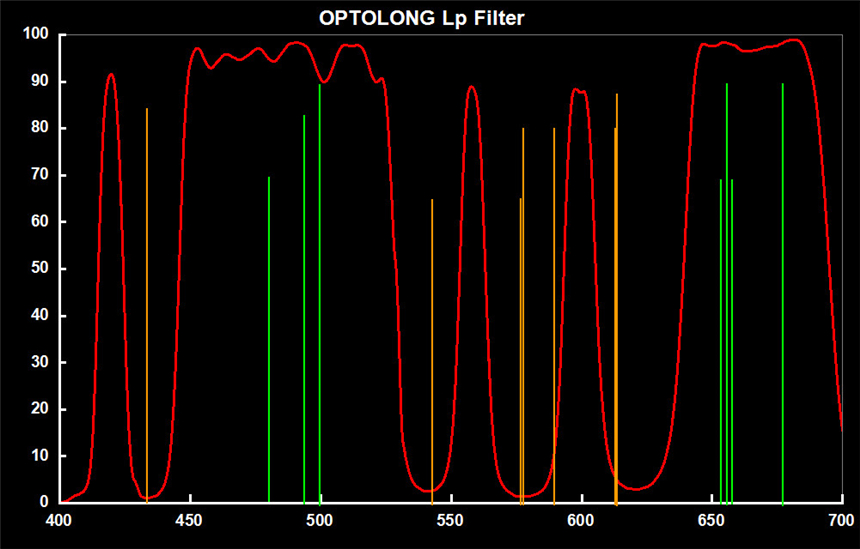
If you’re unfamiliar with how to interpret a filter profile, here’s a quick explanation. The horizontal axis represents the wavelengths of the visible light spectrum, ranging from 400 nm (violet) to 700 nm (red). The vertical axis indicates variations from 0% to 100%. A higher percentage means the filter allows more light at that wavelength, while a lower percentage indicates that the filter blocks light emitted at those wavelengths.
The Optolong L-Pro filter blocks light at four specific ranges: near 425 nm, where LED lights contribute significant blue light pollution; around 535 nm, corresponding to green light emitted by mercury lights; and two dips at 575 nm and 620 nm, blocking most of the yellow and orange light emitted by low and high-pressure sodium lights. However, the filter still allows some light in the yellow and orange range, as demonstrated by the peaks between 540 nm and 625 nm on the graph. This enables users of the Optolong L-Pro to capture (almost) true color images while effectively blocking out the parts of the light spectrum affected by light pollution in urban environments.
Here are two examples of images taken with the L-Pro filter. Please note that the severity of light pollution, the equipment used, and the post-processing skills of amateur astrophotographers may vary. However, these two pictures illustrate the effectiveness of the L-Pro filter in capturing the yellow and orange parts of the light spectrum. The first image, captured by Mr. Photon using the clip-in version of the L-Pro with a DSLR camera, showcases a stunning wide-field view of the Lagoon and Trifid Nebulae situated in one of the brightest regions of our Milky Way. The golden/yellow structures of the Milky Way surrounding the nebulae are clearly visible, highlighting the L-Pro’s ability to capture a (near) true-color representation of the night sky.
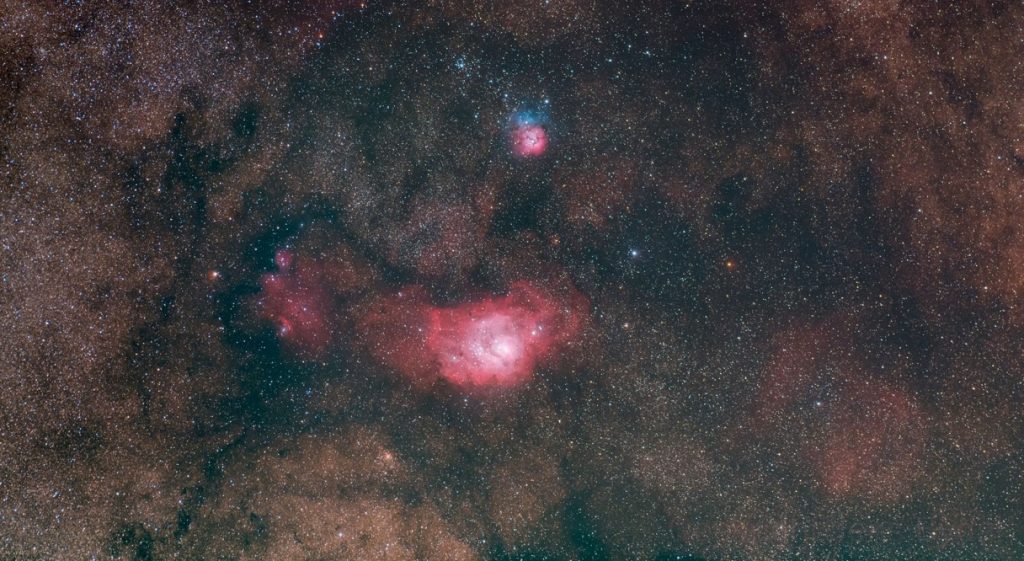
Another example is provided by Ippiu, who utilized a 115mm triplet refractor and the 2″ version of the Optolong L-Pro filter to capture an image of the Pinwheel Galaxy. Once again, the image showcases the distinctively bright yellow core of the galaxy and a yellow star positioned to the left of the Pinwheel Galaxy. This serves as evidence that the L-Pro filter effectively captures colors within the yellow range of the light spectrum.
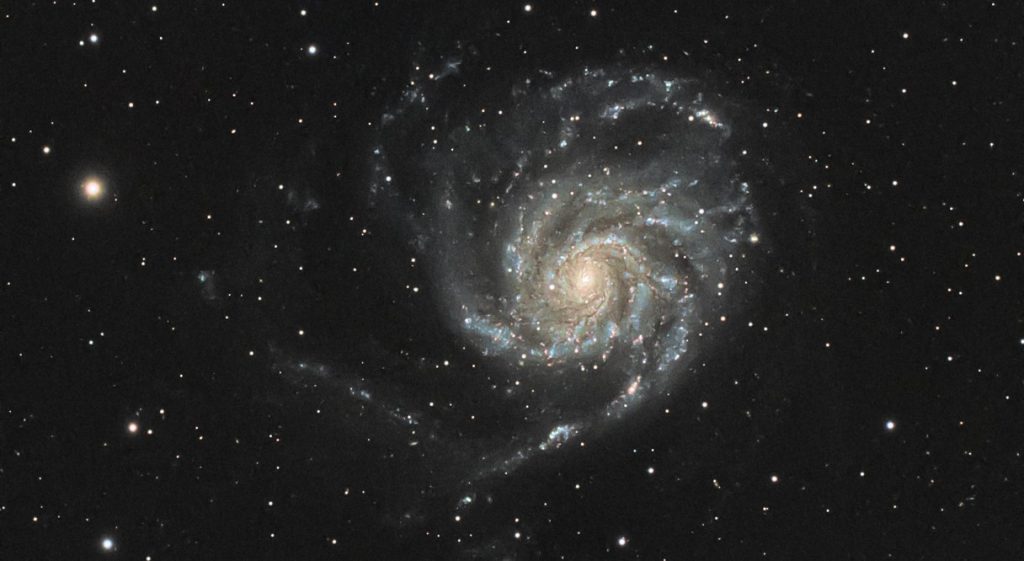
Both images serve as compelling evidence that the L-Pro filter is capable of capturing true color representations of broadband targets while effectively mitigating the impact of urban light pollution on the captured light spectrum. When considering this alongside its reasonable price, it becomes clear why numerous astrophotographers have opted for this particular light pollution filter.
The Optolong L-pro is available here:
The Optolong L-Pro filter is available at Agena Astro (USA/WW), High Point Scientific (USA/WW), and Astroshop (EU/WW) in different formats.
High Point Scientific (USA/WW):
Astroshop (EU/WW) :
- Optolong L-Pro 1.25″
- Optolong L-Pro 2″
- Optolong L-pro Canon APS-C
- Optolong L-pro Canon Full Frame
- Optolong L-pro Nikon Full Frame
BAADER UHC
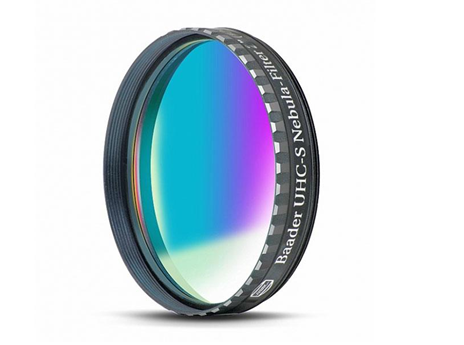
The BAADER UHC-S L-Booster filter is an example of an affordable Ultra High Contrast filter on the astrophotography market today. Baader has been providing many entry level, affordable astrophotography filters for many years. When looking at the profile, it resembles the profile of the Astronomik UHC filter – also effectively blocking out all of the yellow and orange parts of the light spectrum – with one exception. The BAADER UHC-S also captures some light in the (near) infrared part of the light spectrum. This part cannot be detected by any human eye. However, astromodified cameras (without an IR-cut filter) are able to capture light emitted in the infrared. By translating this to a color (e.g. red) your camera is able to pick up additional signals in nebulae that emit part of their light in the (near) infrared.

One example of such a nebula is the California Nebula, which indeed transmits light in the infrared, in addition to transmitting in the visible red part of the light spectrum. This picture made by Franco Panetta shows the shows the California nebula in all its glory, with some additional details being captured in the infrared with the BAADER UHC-S filters that further enhances the red colors in the picture.
The BAADER UHC-S filter is available at Agena Astro (USA/WW), High Point Scientific (USA/WW) and Astroshop (EU/WW) in different formats.
Agena Astro (USA/WW):
High Point Scientific (USA/WW):
Astroshop (EU/WW):
Narrowband Filters
Narrowband imaging is another way to combat light pollution and take beautiful pictures of deep-sky objects. The main aim is not to create a so-called “true color” picture of the object but to capture specific elements that are present within a deep sky object. Most astrophotographers use narrowband filters to capture the many beautiful emission nebulae in our milky way. These nebulae often emit huge quantities of hydrogen and oxygen. Other elements such as sulfur are often present as well and can also be captured.
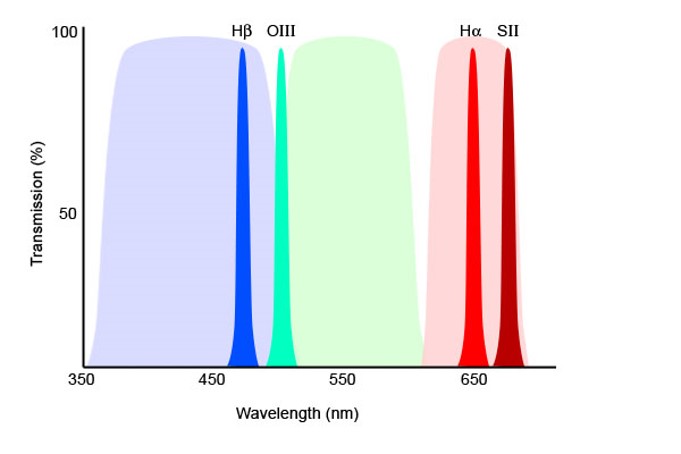
Hydrogen-Alpha – 656.3nm
The most dominant emission line in a star-forming region such as the Orion Nebula is called hydrogen-alpha, or H-alpha. This light is created by hydrogen, the primary building block of the universe. H-alpha is in the red part of the spectrum and contributes to the (strong) red color of most nebulae.
Oxygen-III – 500.7nm
This line is given off by doubly-ionized oxygen atoms. This line is in the blue-green portion of the spectrum. The OIII filter is often used to capture the dominant emissions from planetary nebulae.
Sulfur-II – 672.4nm
Singly ionized sulfur emits light in the deep red part of the spectrum, beyond H-alpha. It is a weaker emission than H-alpha and OIII, but it is the most common filter used after these two.
Hydrogen-Beta – 486.1nm
Hydrogen gives off light at several wavelengths. The second most common, after H-alpha, is the H-beta line in the blue part of the spectrum.
Use cases for narrowband astrophotography
There are two primary approaches to capturing narrowband data in astrophotography. The first method involves using a color camera equipped with narrowband filters to simultaneously capture multiple “bands.” These filters are commonly referred to as quad-band, tri-band, or dual-band filters, depending on their ability to capture four, three, or two specific elements respectively. It is important to note that color cameras, which incorporate a Bayer filter in front of the sensor, are less susceptible to capturing narrowband data compared to monochrome cameras (check this blog for more in-depth information). However, working with a color camera saves significant time and is relatively easier since it eliminates the need to capture individual elements separately using separate filters. In the following sections, I will discuss popular narrowband filters suitable for use with a color camera, followed by a discussion on popular narrowband filters typically utilized in conjunction with a monochrome camera.
Optolong L-eNhance

The Optolong L-eNhance is an affordable and popular narrowband filter designed for astrophotographers who want to capture the H-alpha, H-beta, and Oiii emission lines of deep sky objects using a color camera. One significant advantage of the L-eNhance over regular UHC (broadband) light pollution filters is its ability to further enhance the signal-to-noise ratio by blocking additional wavelengths that may contribute to noise. Using a single filter in combination with a regular color camera, such as a DSLR or OSC, simplifies the narrowband imaging process compared to mono narrowband astrophotography. While a mono camera allows for capturing more light in these wavelengths, it introduces complexity, requiring the use of different narrowband filters and potentially a filter wheel, significantly increasing the time spent on imaging and post-processing.
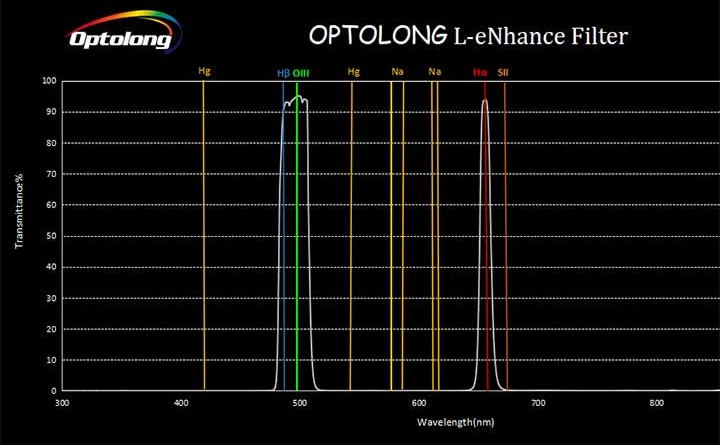
It’s important to note that, like all narrowband filters, the resulting image will have a false color representation of the deep sky object. If your goal is to capture the night sky in its natural colors, narrowband imaging may not be suitable. However, if you are open to embracing the unique characteristics of narrowband astrophotography, you’ll be astounded by the high signal-to-noise ratio it offers. The Optolong L-eNhance filter is particularly effective in capturing targets that emit light from ionized hydrogen (alpha and beta) and oxygen elements. Some remarkable targets in the northern hemisphere include the Cygnus loop (including the eastern and western Veil Nebula), the Pelican Nebula, and the North America Nebula, among others. In the southern hemisphere (depending on your latitude), the Carina nebula, the Lagoon Nebula, and the Eagle Nebula are two additional examples where this filter can produce impressive results.
False color pictures can be quite impressive. See for example this picture from raga79co of the western veil nebula, taken with an Optolong L-eNhance filter. The picture shows the beautiful ionized hydrogen and oxygen clouds in red and blue, left by a star that went supernova about ten thousand years ago.

The Optolong L-eNhance filter is available here:
Agena Astro (USA/WW):
High Point Scientific (USA/WW):
Astroshop (EU/WW):
Optolong L-eXtreme
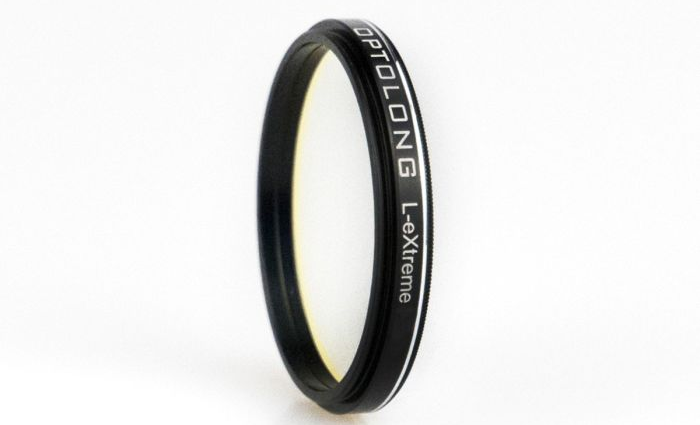
The Optolong 1.25″ L-eXtreme filter is an enhanced version of the popular L-eNhance filter, designed to provide even greater contrast when capturing emission nebulae, planetary nebulae, and supernova remnants in astrophotography. This filter offers a dual-band configuration, incorporating two narrow passbands for precise targeting of specific wavelengths. The first passband has a width of 7nm and is centered on the H-alpha line at 656nm, while the second passband also has a width of 7nm and is centered on the OIII line near 501nm. These wavelengths correspond to the strongest emission lines observed in the majority of nebulae.

What sets the L-eXtreme apart from its predecessor is its exclusion of the weaker H-beta emission line at 486nm. By blocking this specific wavelength, the L-eXtreme achieves enhanced contrast in the fainter regions of nebulae, even in light-polluted skies. The narrower passbands of the filter are particularly advantageous in suppressing moonlight and broadband light pollution commonly found in urban and suburban areas. Here’s an example of IC5070, the pelican nebula, taken by Corioda with a color camera using the Optolong L-eXtreme filter. The red hydrogen alpha line is transformed to yellow/gold in this picture.
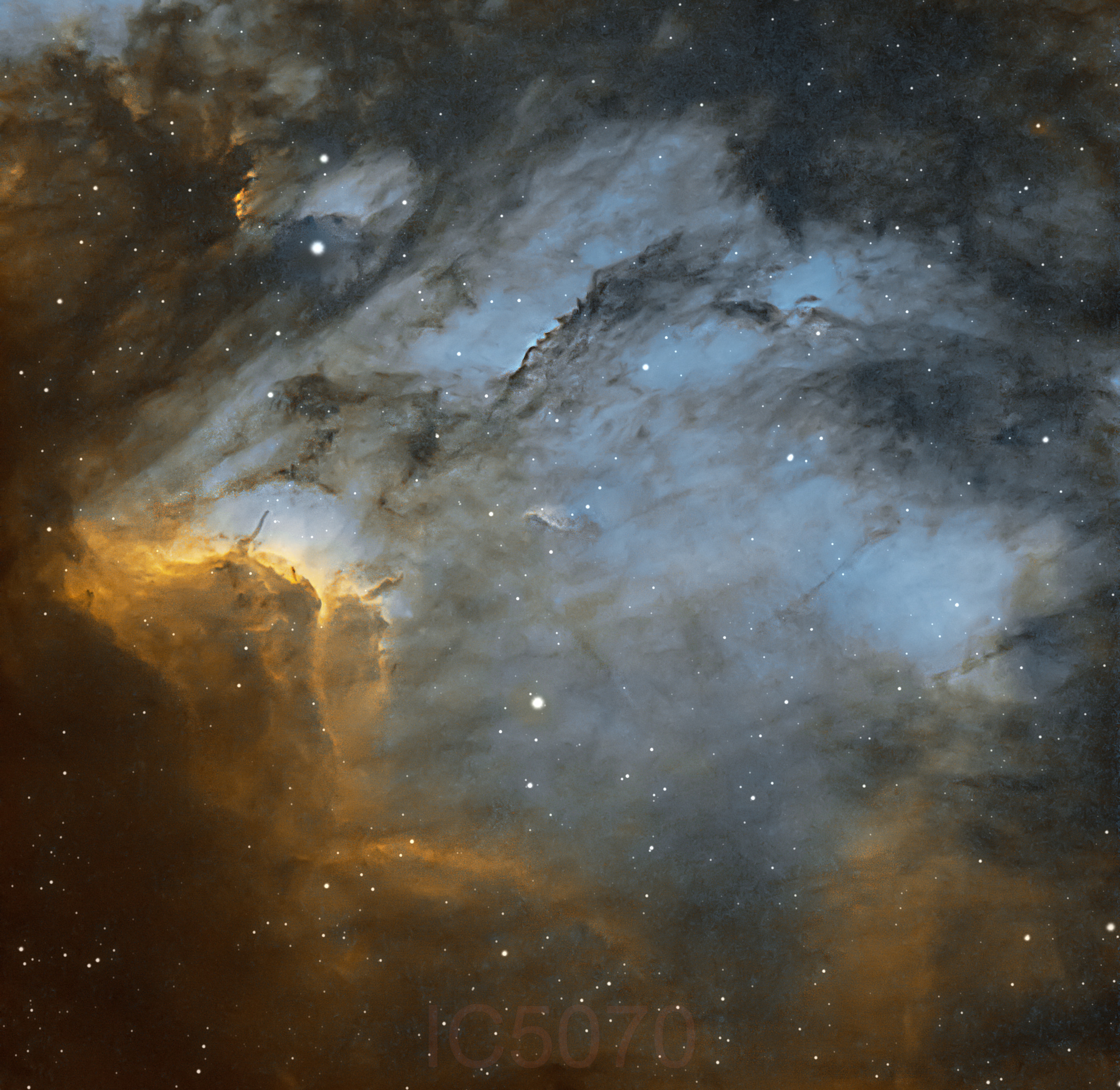
The L-eXtreme filter is well-suited for use with DSLR cameras and one-shot color (OSC) imaging systems, providing astrophotographers with a powerful tool for capturing stunning images of celestial objects while effectively mitigating the impact of light pollution.
The Optolong L-eXtreme filter is available here:
Agena Astro (USA/WW):
High Point Scientific (USA/WW):
Astroshop (EU/WW):
ZWO 7nm H-alpha, Sii, Oiii separate filters

The ZWO 1.25″ SHO Filter Set consists of three mounted astrophotography filters designed to allow narrowband light transmission within a 7nm band. These filters are specifically tailored for capturing ionized sulfur (SII) at 672nm, hydrogen-alpha (H-alpha) at 656nm, and ionized oxygen (OIII) near 500nm. When used in conjunction with a monochrome astronomy camera, individual images taken with each filter can be combined using standard processing techniques to produce high-contrast images of various celestial objects such as emission nebulae (e.g., Orion, Lagoon, and Eagle Nebulae), planetary nebulae (e.g., Ring, Dumbbell, and Helix Nebulae), and supernova remnants like the Veil Nebula. The filters in this set effectively block ultraviolet (UV) and infrared (IR) light to ensure sharp star images. Each filter in the set is 2mm thick, polished to a ¼-wave, and fully multicoated to ensure optimal image quality. With peak transmission exceeding 80% at each passband, the ZWO narrowband SHO filter set is ideally suited for use with monochrome cameras and manual or electronic filter wheels compatible with 1.25″ mounted filters. For instance, I have successfully integrated these filters into a dedicated filter wheel, which is placed in front of my ZWO ASI 1600MM and 2600MM Pro cameras.
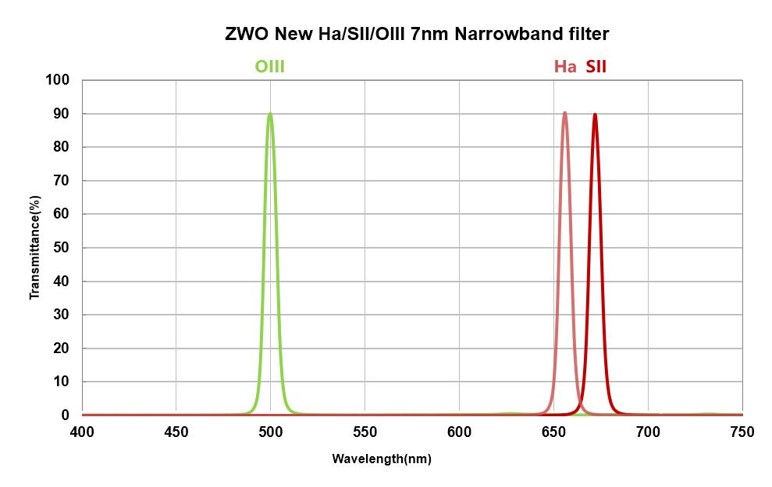
This picture of the Crescent Nebula below – in HOO using the 7nm Ha and Oiii filters – is just one example of many pictures I’ve taken using these ZWO narrowband filters. Most of my nebulae pictures you can see here are taken with ZWO 7nm narrowband filters.
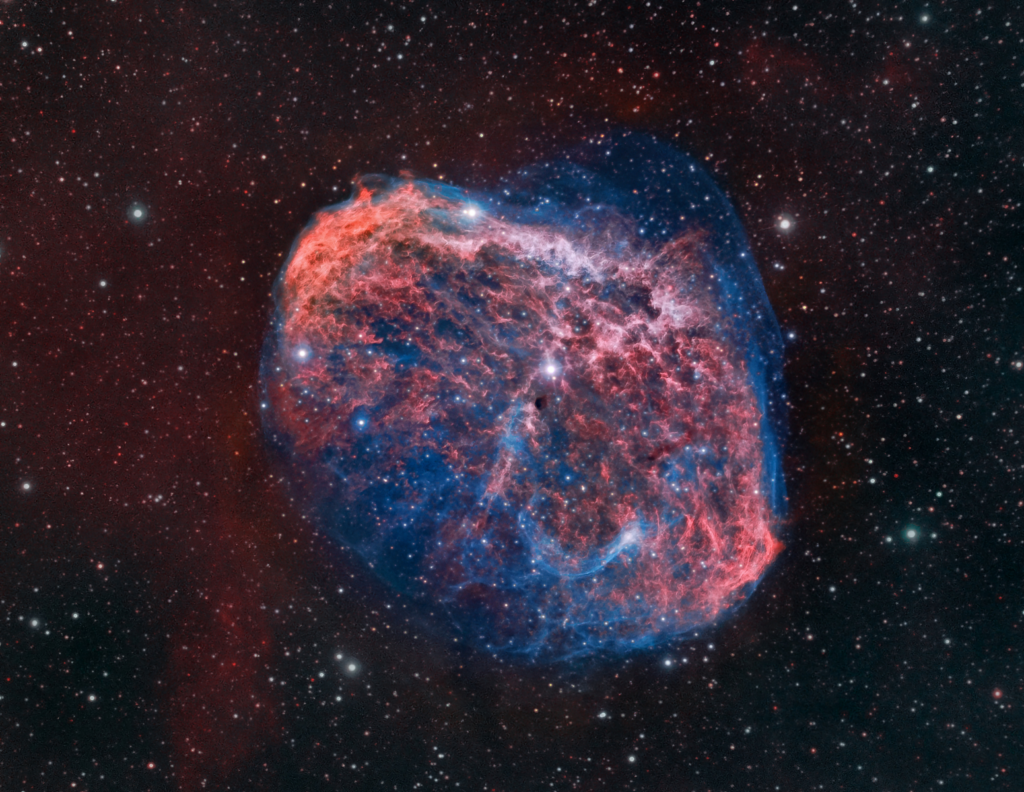
The ZWO 7nm narrowband HSO filter set is available here:
Agena Astro (USA/WW):
High Point Scientific (USA/WW):
Astroshop (EU/WW):
Optolong H-alpha, Sii, Oiii filter set (6.5nm/3nm)
Optolong also offers 6.5nm and 3nm narrowband filters for an affordable price. The packages include three narrowband filters: SII, H-Alpha, and OIII. These filters are commonly used in conjunction with astronomical monochrome and cooled Astro-cameras. By corresponding with the RGB channels (Sii, HA, OIII), astrophotographers can process their images to achieve a Hubble-like appearance using specialized astronomical post-processing software. The H-Alpha filter is a popular narrowband option, allowing a narrow bandwidth of light centered on a wavelength of 656nm. It effectively reduces the transmission of artificial light wavelengths, including those emitted by mercury vapor, high and low-pressure vapor lights, and unwanted natural light caused by neutral oxygen emission in our atmosphere (i.e., skyglow). This filter is an excellent choice for astrophotographers seeking high contrast and the ability to reveal subtle details within nebulae. The Narrowband OIII filter is specifically designed for nebula observation. It enables the transmission of light within a narrow bandwidth centered on a wavelength of 500nm, corresponding to the OIII emission line. Similarly, it effectively blocks unwanted wavelengths produced by artificial light and natural skyglow caused by neutral oxygen emission. OIII filters are often utilized alongside H-Alpha filters to capture planetary nebulae and supernova remnants, offering detailed structural information. The Narrowband SII filter, also known as Sulfur II, is tailored for nebula observation. It allows the transmission of light within a narrow bandwidth centered on a wavelength of 672nm. It effectively blocks unwanted wavelengths from artificial light and skyglow caused by neutral oxygen emission. By using the SII filter in combination with other narrowband filters, astrophotographers can capture sulfur-rich nebulae, enhancing their visibility and contrast.
Optolong offers narrowband filters with narrowband options of 7nm, 6.5nm, and 3nm. By selecting filters that capture narrower wavelengths, you can enhance your signal-to-noise ratio, resulting in reduced time required for capturing deep-space objects and the possibility of achieving a greater dynamic range in your astrophotography images. This amazing picture of the Carina Nebula was taken by Logan Carpenter using Optolongs HSO (7nm & 6.5nm) narrowband filters.
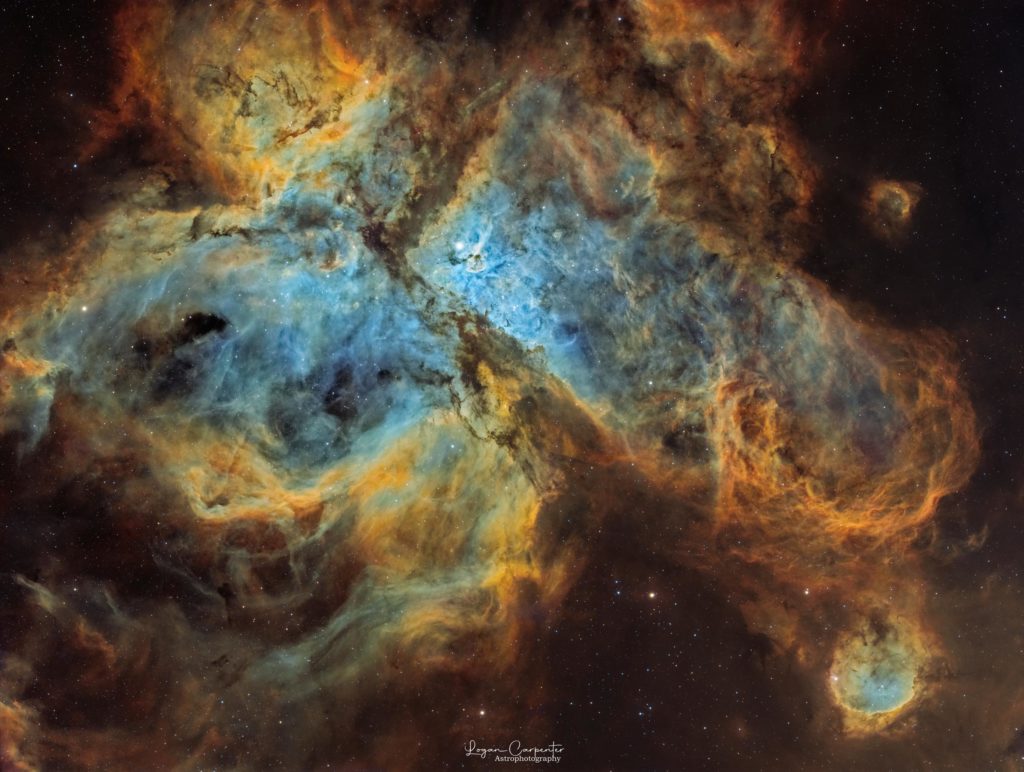
The Optolong 7nm, 6.5nm, and 3nm Sii, H-alpha, and Oiii narrowband filter sets are available here:
Agena Astro (USA / WW):
- Optolong LRGB, 6.5nm S-II, 7nm H-a & 6.5nm O-III Filter Set for 1.25″
- Optolong LRGB, 6.5nm S-II, 7nm H-a & 6.5nm O-III Filter Set for 2″
- Optolong SHO (S-II, H-a & O-III) Narrowband 3nm Filter Set for 2″
High Point Scientific (USA/WW):
- Optolong LRGB, 6.5nm S-II, 7nm H-a & 6.5nm O-III Filter Set for 1.25″
- Optolong LRGB, 6.5nm S-II, 7nm H-a & 6.5nm O-III Filter Set for 2″
- Optolong SHO (S-II, H-a & O-III) Narrowband 3nm Filter Set for 2″
Astroshop (EU/WW):
- Optolong SHO, 6.5nm Sii, 7nm H-alpha & 6.5nm Oiii filter set for 1.25″
- Optolong SHO, 6.5nm Sii, 7nm H-alpha & 6.5nm Oiii filter set for 2″
- Optolong SHO (S-II, H-a & O-III) Narrowband 3nm Filter Set for 2″
In cases where finding a dark sky location is not feasible, there are other ways to make a difference. One option is to take an active role and raise awareness among local governments about the issue of light pollution. By providing them with information and suggesting solutions, we can help them understand the negative impact of excessive artificial lighting in urban areas. It’s important to emphasize that light pollution not only affects astrophotography enthusiasts like ourselves, but it is also wasteful and disrupts the natural circadian rhythms of wildlife. By working together, we can encourage measures to limit light pollution and create a more sustainable environment for both humans and wildlife.
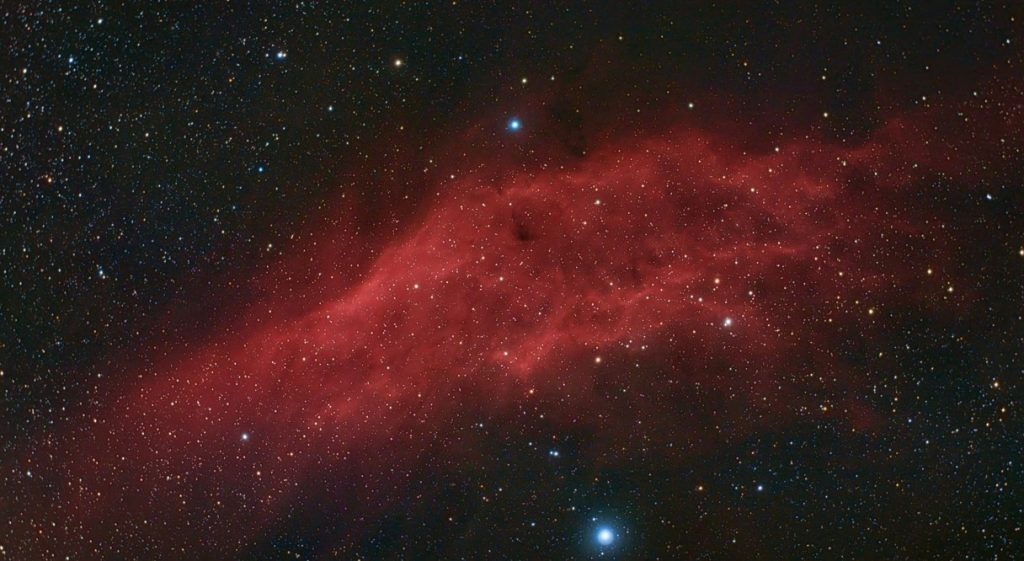
Hi Wido,
This is Mike from Chicago. Thanks again for you note via YouTube. A Ha filter is next on my list but I think I need to learn PHD2, APT first. I also think I am most likely heading to narrow band imaging especially in Chicago skies. I have seen a lot of folks using the ASI 1600 MM coupled to an ZWO EFW. Is this reasonable for a very early beginner like me? Also, should I consider a clip in Ha filter first – just for learning and portability? I have a 2″ Optolong L-Pro and was also thinking about getting the L-Enhance as well? Thoughts?
By the way, you may be interested in knowing that my wife is an I/O pyschologist. I will send along a LinkedIN invite. She retired from corporate life and has been working for the American Red Cross for the last several years. Thanks again for your guidance.
Best,
Mike
Hi Mike,
Good to know I’m not the only I/O psychologist, thanks for the invite. Yes, these are always difficult choices to make. As for me, I first practiced astrophotography with a DSLR + PHD2 and some clip in filters. I started with backyard EOS as an easy to use imaging tool. After I learned how to autoguide and how to post process in deepsky stacker and Photoshop I switched to the ZWO1600mm Pro and an 8 position filterwheel with 1.25″ ZWO LRGB and Ha, Sii, Oiii filters to start mono imaging. Perhaps a good solution is to start imaging with a color camera and some dedicated light pollution and narrowband filters (Lpro, Lextreme) as you mention above and later make the switch to mono imaging. Perhaps my blog about mono vs. colour imaging (see my website or YT channel) is useful to read/watch in which I discuss the pros and cons regarding colour vs. mono imaging. Hope my info is useful and you’ll enjoy the hobby despite the light polluted skies of Chicago!
Best,
Wido.
Greetings:
I’m reaching out to inquire if you are interested in joining our affiliate program to earn commissions from references from your content. We offer higher than industry commission rates as we are the manufacturer of the products we sell. We use a well respected Affiliate system (Share A Sale) and have a team ready to provide assistance. We can generate text and graphics affiliate links for your specific content needs.
You can view our e-commerce store here: http://www.farpointastro.com
Please read about our program here: https://farpointastro.com/pages/affiliate-program
You can sign up here: http://www.shareasale.com/shareasale.cfm?merchantId=104739
You can see a sample of content with an already existing Affiliated Marketing partner here: Building a JMI Wheeley Bar with Pneumatic Wheels-Not and Unboxing! – YouTube
Please let me know what you think as I would like to work with you.
Norik Kitay
Chief Operating Officer
Optical Structures Inc.
11371 Pyrites Way, Suite A
Rancho Cordova, CA 95670
Direct: (916)306-0763
Email: Norik@opticalstructures.com
Our brands:
http://www.Astrodon.com
http://www.FarpointAstro.com
http://www.Lumicon.com
http://www.OpticWaveLabs.com
What about your take on the CLS/CCD filter?
Thanks much!